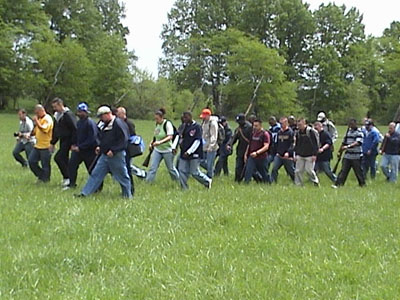Lessons from Centralia
“The light bulb comes on,†said Lt. Col. (ret.) Dave Chuber, regimental historian with the U. S. Army Chemical School at Fort Leonard Wood, Missouri. “They look at details like forming a line of battle instead of a square, etc., etc., but the bottom line is these guys look around them and realize, ‘we just walked into a trap.’â€
“And,†Chuber adds, “that’s exactly what the guerrillas wanted.â€
The parallels between the events that occurred more than a century ago on this out-of-the-way patch of prairie in Missouri and what is happening today in the streets and sands of Iraq and Afghanistan are striking. Some of the men here have already served one tour in Iraq or Afghanistan. They look around incredulously and wonder, “why didn’t they tell us this story before?â€
{default}Major Johnston’s actions are discussed. When he led his company out of Centralia and into the ambush was he thinking clearly? Or had the emotions from witnessing the carnage in town taken over?

Likewise, regarding his men, said Chuber. “I’m not saying green Soldiers can’t fight but they go on their emotions because they haven’t learned anything.â€
The purpose of the staff ride is to insure that soldiers do learn something. About 200 students will take part in the Centralia Staff Ride this year. Soldiers study the motivations, tactics, results. They try to draw out the enduring and timeless lessons of combat that will save their lives and the lives of those they command. So what are the lessons from Centralia, from the “black flag†war that was Kansas and Missouri during the Civil War?
Lt. Col. (ret.) Ed Kennedy, Jr., of the Army’s Command and General Staff College cautioned against taking Centralia out of context. “Centralia was only a symptom of the type of war being fought in Missouri,†he said. “It was not the first such action.â€
He explained that by 1862, conventional Confederate forces had been driven from Missouri leaving thousands of men who had shown little inclination to fight on either side of the war. When Federal commanders sought to force loyalty and compliance through draconian measures, resentment bubbled over into retaliation. Several U. S. officers were eventually court-martialed for war crimes, but not until they had burned, plundered, murdered — and more importantly — forced “fence-sitting†Missourians into supporting the enemy.
Even then, some Federals realized this approach was doomed. Chuber quoted an officer from the time, “We can’t keep growing guerrillas! Every time we make a mistake another guerilla is born.â€

Thus, one of the most important lessons drawn from the Centralia Massacre is to be careful how you treat the population. Back in his office at Fort Leavenworth, Kennedy pops a CD into his computer and turns on a newscast of the occupation in Baghdad. Strictly enforcing a mandated curfew, American servicemen run over a violator’s car with their tank; not once, but over and over. The car was the means of support for this man’s family and it’s loss left them destitute. The next time Americans come to his door, what will that Iraqi do? Will he lie about the whereabouts of Al Quaeda? Will he turn away as they walk into an ambush? Will he plant a bomb?
“We can’t keep growing guerrillas,†says Chuber, “else we’ll be in this war forever.â€
We cannot afford to forget Centralia.
Discuss this article in our forums!

